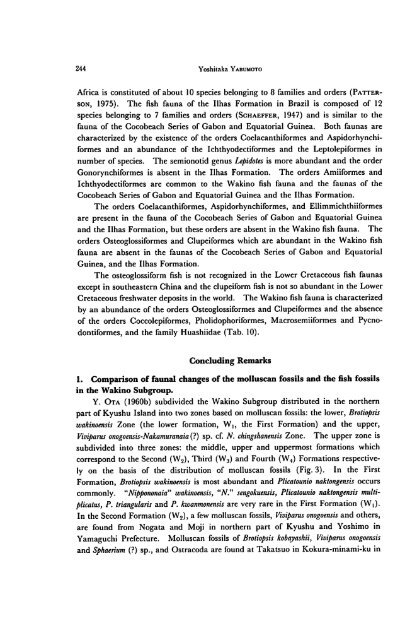Early Cretaceous Freshwater Fish Fauna in Kyushu, Japan
Early Cretaceous Freshwater Fish Fauna in Kyushu, Japan
Early Cretaceous Freshwater Fish Fauna in Kyushu, Japan
You also want an ePaper? Increase the reach of your titles
YUMPU automatically turns print PDFs into web optimized ePapers that Google loves.
244 Yoshitaka Yabumoto<br />
Africa is constituted of about 10 species belong<strong>in</strong>g to 8 families and orders (Patter<br />
son, 1975). The fish fauna of the Ilhas Formation <strong>in</strong> Brazil is composed of 12<br />
species belong<strong>in</strong>g to 7 families and orders (Schaeffer, 1947) and is similar to the<br />
fauna of the Cocobeach Series of Gabon and Equatorial Gu<strong>in</strong>ea. Both faunas are<br />
characterized by the existence of the orders Coelacanthiformes and Aspidorhynchiformes<br />
and an abundance of the Ichthyodectiformes and the Leptolepiformes <strong>in</strong><br />
number of species. The semionotid genus Lepidotes is more abundant and the order<br />
Gonorynchiformes is absent <strong>in</strong> the Ilhas Formation. The orders Amiiformes and<br />
Ichthyodectiformes are common to the Wak<strong>in</strong>o fish fauna and the faunas of the<br />
Cocobeach Series of Gabon and Equatorial Gu<strong>in</strong>ea and the Ilhas Formation.<br />
The orders Coelacanthiformes, Aspidorhynchiformes, and Ellimmichthiiformes<br />
are present <strong>in</strong> the fauna of the Cocobeach Series of Gabon and Equatorial Gu<strong>in</strong>ea<br />
and the Ilhas Formation, but these orders are absent <strong>in</strong> the Wak<strong>in</strong>o fish fauna. The<br />
orders Osteoglossiformes and Clupeiformes which are abundant <strong>in</strong> the Wak<strong>in</strong>o fish<br />
fauna are absent <strong>in</strong> the faunas of the Cocobeach Series of Gabon and Equatorial<br />
Gu<strong>in</strong>ea, and the Ilhas Formation.<br />
The osteoglossiform fish is not recognized <strong>in</strong> the Lower <strong>Cretaceous</strong> fish faunas<br />
except <strong>in</strong> southeastern Ch<strong>in</strong>a and the clupeiform fish is not so abundant <strong>in</strong> the Lower<br />
<strong>Cretaceous</strong> freshwater deposits <strong>in</strong> the world. The Wak<strong>in</strong>o fish fauna is characterized<br />
by an abundance of the orders Osteoglossiformes and Clupeiformes and the absence<br />
of the orders Coccolepiformes, Pholidophoriformes, Macrosemiiformes and Pycnodontiformes,<br />
and the family Huashiidae (Tab. 10).<br />
Conclud<strong>in</strong>g Remarks<br />
1. Comparison of faunal changes of the molluscan fossils and the fish fossils<br />
<strong>in</strong> the Wak<strong>in</strong>o Subgroup.<br />
Y. Ota (1960b) subdivided the Wak<strong>in</strong>o Subgroup distributed <strong>in</strong> the northern<br />
part of <strong>Kyushu</strong> Island <strong>in</strong>to two zones based on molluscan fossils: the lower, Brotiopsis<br />
wak<strong>in</strong>oensis Zone (the lower formation, W,, the First Formation) and the upper,<br />
Viviparus onogoensis-Nakamuranaia (?) sp. cf. N. ch<strong>in</strong>gshanensis Zone. The upper zone is<br />
subdivided <strong>in</strong>to three zones: the middle, upper and uppermost formations which<br />
correspond to the Second (W2), Third (W3) and Fourth (W4) Formations respective<br />
ly on the basis of the distribution of molluscan fossils (Fig.3). In the First<br />
Formation, Brotiopsis wak<strong>in</strong>oensis is most abundant and Plicatounio naktongensis occurs<br />
commonly. "Nippononaia" wak<strong>in</strong>oensis, "N." sengokuensis, Plicatounio naktongensis multiplicatus,<br />
P. triangularis and P. kwanmonensis are very rare <strong>in</strong> the First Formation (Wi).<br />
In the Second Formation (W2), a few molluscan fossils, Viviparus onogoensis and others,<br />
are found from Nogata and Moji <strong>in</strong> northern part of <strong>Kyushu</strong> and Yoshimo <strong>in</strong><br />
Yamaguchi Prefecture. Molluscan fossils of Brotiopsis kobayashii, Viviparus onogoensis<br />
and Sphaerium (?) sp., and Ostracoda are found at Takatsuo <strong>in</strong> Kokura-m<strong>in</strong>ami-ku <strong>in</strong>

















